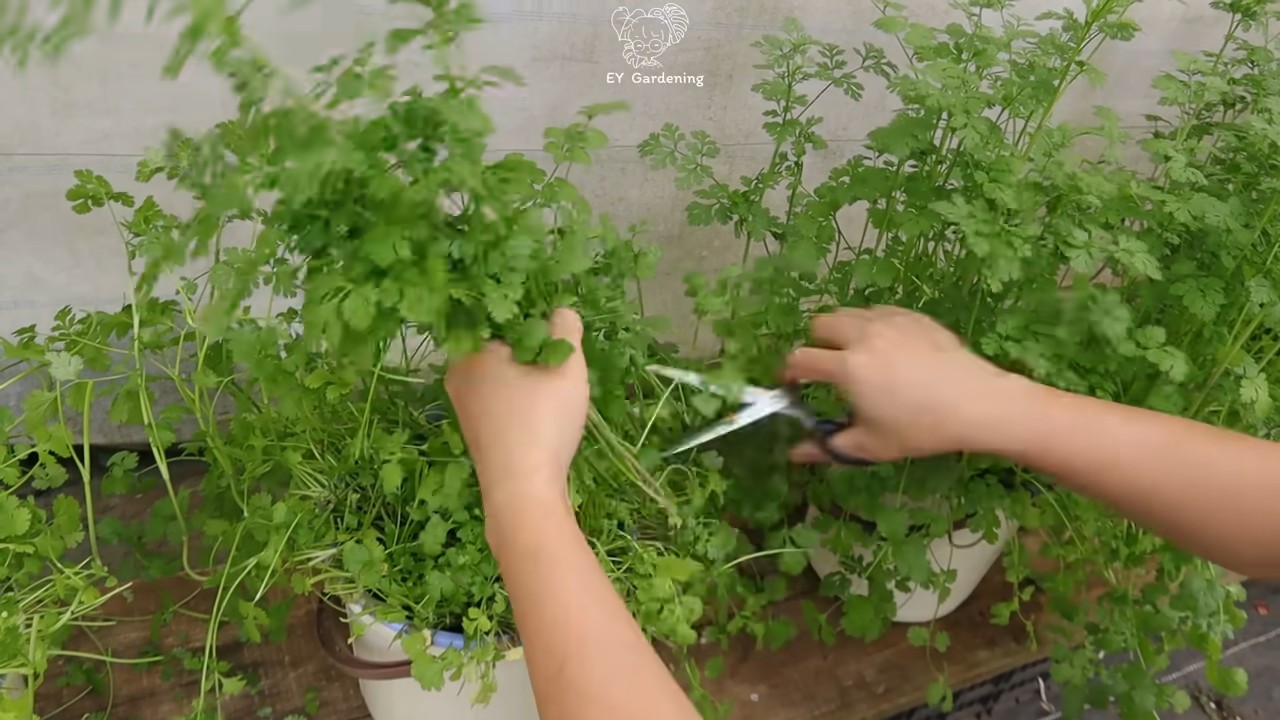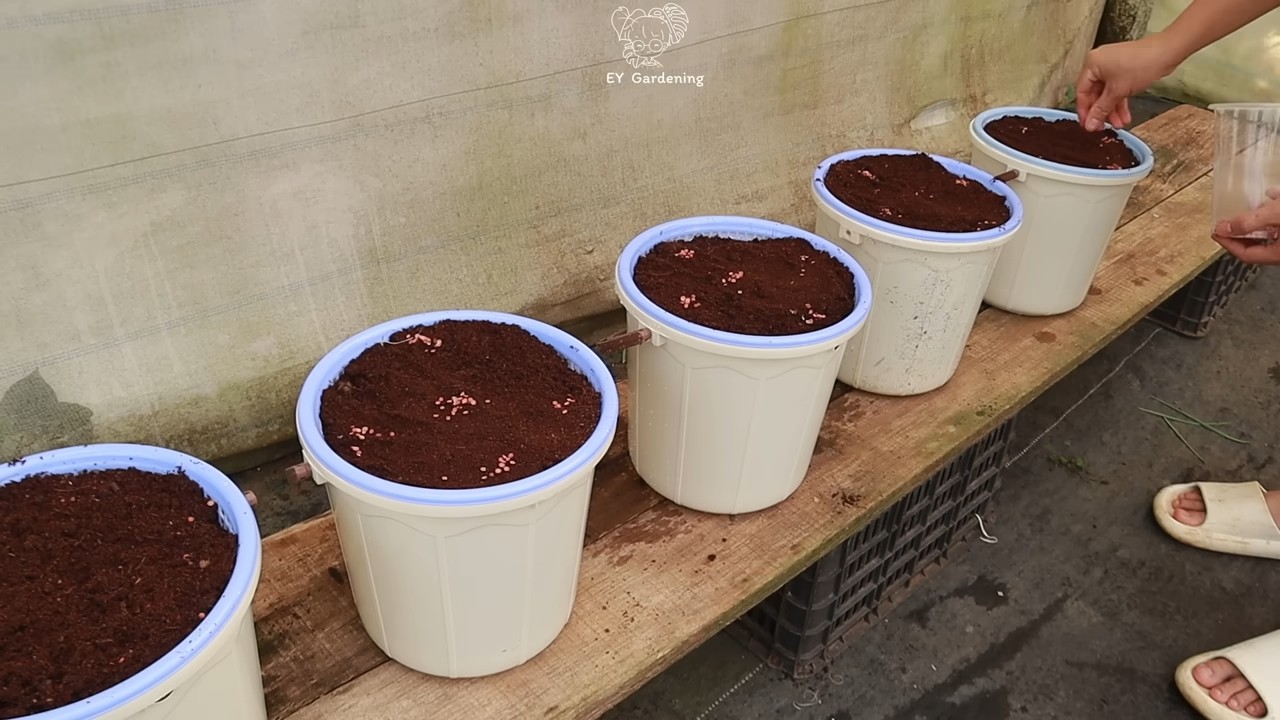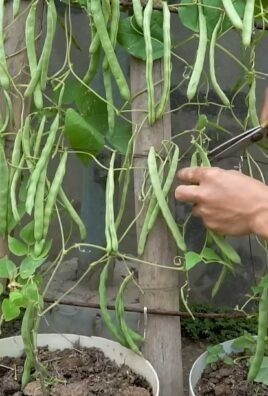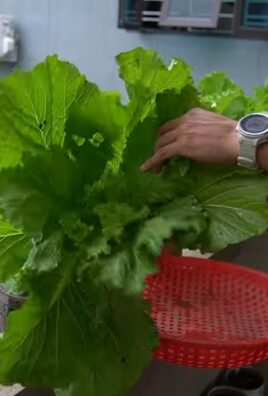Growing Coriander in Water: Unlock the secrets to effortlessly cultivating this fragrant herb right in your kitchen! Have you ever dreamt of snipping fresh coriander leaves whenever you need them, without even stepping outside? Imagine the burst of flavor you can add to your tacos, curries, and salads, all thanks to your own little indoor garden.
Coriander, also known as cilantro in some parts of the world, has a rich history dating back thousands of years. Evidence suggests its use in ancient Egypt, and it has been a staple in Asian and Mediterranean cuisines for centuries. But you don’t need to be an ancient civilization to enjoy its benefits!
In today’s busy world, convenience is key. We often find ourselves rushing to the grocery store for a bunch of coriander, only to use a fraction of it before it wilts away in the fridge. That’s where this DIY trick comes in! Growing coriander in water is a simple, sustainable, and cost-effective way to have a constant supply of fresh herbs at your fingertips. I’m going to show you how to bypass the soil and grow coriander in water, saving you time, money, and reducing food waste. Let’s get started and transform your kitchen into a mini herb haven!

Growing Coriander in Water: A Simple DIY Guide
Hey there, fellow plant enthusiasts! Ever wished you could have fresh coriander (cilantro) on hand whenever you needed it, without the hassle of soil and traditional gardening? Well, you’re in luck! I’m going to walk you through a super easy DIY method for growing coriander in water. It’s a fantastic way to propagate your existing coriander plants or even start from store-bought bunches. Let’s get started!
What You’ll Need
Before we dive in, let’s gather our supplies. This is a pretty low-key project, so you probably have most of these things lying around already.
* Coriander Stems: You can use stems from your garden or even the ones you buy at the grocery store. Look for healthy-looking stems with nodes (those little bumps where leaves grow) along the lower part.
* A Glass or Jar: Any clean glass or jar will do. Make sure it’s wide enough to hold the stems upright and deep enough to submerge the nodes in water.
* Water: Tap water is fine, but letting it sit out for a day or two to allow the chlorine to dissipate is even better. Filtered water works great too.
* Scissors or a Sharp Knife: For trimming the stems.
* Optional: Rooting Hormone: This isn’t essential, but it can speed up the rooting process. I’ll explain how to use it later.
* Optional: Liquid Fertilizer: Once the roots develop, a little diluted liquid fertilizer can give your coriander a boost.
Preparing the Coriander Stems
Okay, let’s get those coriander stems ready for their watery adventure!
1. Select Healthy Stems: Choose stems that are firm, green, and free from any signs of wilting or damage. The healthier the stem, the better the chances of successful rooting.
2. Trim the Lower Leaves: Carefully remove the leaves from the bottom 1-2 inches of the stem. This is important because these submerged leaves will rot and contaminate the water, hindering root growth. Use your fingers or scissors to gently pluck them off.
3. Cut the Stem (Optional): If the stem is particularly long, you can trim it down to about 4-6 inches. This isn’t strictly necessary, but it can make the stem easier to manage in the glass. Make sure to cut just below a node.
4. Rooting Hormone (Optional): If you’re using rooting hormone, now’s the time to apply it. Dip the cut end of the stem into the hormone powder or solution, following the instructions on the product label. This will encourage faster and more robust root development.
Setting Up Your Water Propagation Station
Now that our stems are prepped, let’s create the perfect environment for them to grow roots.
1. Fill the Glass with Water: Pour water into your glass or jar, leaving about an inch of space at the top.
2. Arrange the Stems: Gently place the coriander stems into the water, ensuring that the nodes (where you removed the leaves) are submerged. Don’t overcrowd the glass; give each stem some space to breathe.
3. Choose the Right Location: Place the glass in a bright, indirect light location. Avoid direct sunlight, as it can overheat the water and damage the stems. A windowsill with filtered light or a spot near a lamp is ideal.
Caring for Your Water-Grown Coriander
This is where the magic happens! With a little care and attention, you’ll soon see those roots sprouting.
1. Change the Water Regularly: This is crucial! Change the water every 1-2 days to prevent bacterial growth and keep the water fresh. Stagnant water can lead to rot and kill your coriander.
2. Monitor Root Growth: Keep an eye on the stems for signs of root development. You should start to see tiny roots emerging from the nodes within a week or two.
3. Add Liquid Fertilizer (Optional): Once the roots are about an inch long, you can start adding a diluted liquid fertilizer to the water every other week. Use a balanced fertilizer and dilute it to half strength to avoid burning the roots.
4. Top Up the Water: As the water evaporates, top it up with fresh water to ensure the nodes remain submerged.
5. Be Patient: Rooting can take time, so don’t get discouraged if you don’t see results immediately. Just keep changing the water and providing bright, indirect light, and eventually, those roots will appear.
Transplanting Your Coriander (Optional)
Once the roots are well-developed (a few inches long), you have a couple of options:
* Continue Growing in Water: You can continue to grow your coriander in water indefinitely. Just remember to change the water regularly and provide nutrients with liquid fertilizer.
* Transplant to Soil: If you prefer to grow your coriander in soil, you can transplant it to a pot or garden bed.
Transplanting to Soil: A Step-by-Step Guide
If you choose to transplant your coriander to soil, here’s how to do it:
1. Prepare a Pot or Garden Bed: Choose a pot with drainage holes or a well-draining spot in your garden. Coriander prefers well-drained soil that is rich in organic matter.
2. Fill with Soil: Fill the pot or garden bed with a good quality potting mix or garden soil.
3. Create a Hole: Dig a small hole in the soil, large enough to accommodate the roots of the coriander plant.
4. Carefully Remove the Plant: Gently remove the coriander plant from the water, being careful not to damage the roots.
5. Place in the Hole: Place the plant in the hole and gently spread out the roots.
6. Cover with Soil: Cover the roots with soil and gently pat it down.
7. Water Thoroughly: Water the plant thoroughly after transplanting.
8. Provide Shade: For the first few days after transplanting, keep the plant in a shady location to help it adjust to its new environment.
9. Gradually Introduce Sunlight: Gradually introduce the plant to more sunlight over the next week or two.
Troubleshooting
Even with the best intentions, things can sometimes go wrong. Here are a few common problems you might encounter and how to fix them:
* Stems Rotting: This is usually caused by stagnant water or bacterial contamination. Make sure you’re changing the water regularly and removing any dead leaves.
* No Root Growth: This could be due to a number of factors, including poor stem quality, insufficient light, or lack of nutrients. Try using rooting hormone, moving the glass to a brighter location, or adding a diluted liquid fertilizer.
* Yellowing Leaves: This can be a sign of overwatering or nutrient deficiency. Make sure the soil is well-draining and that you’re providing adequate nutrients.
* Pests: While less common in water propagation, pests can sometimes be a problem. If you notice any pests, such as aphids or spider mites, treat the plant with an appropriate insecticide.
Tips for Success
Here are a few extra tips to help you succeed with growing coriander in water:
* Use Fresh Water: Always use fresh, clean water when propagating coriander.
* Avoid Overcrowding: Don’t overcrowd the glass with too many stems.
* Provide Adequate Light: Coriander needs bright, indirect light to grow.
* Be Patient: Rooting can take time, so don’t get discouraged if you don’t see results immediately.
* Experiment: Don’t be afraid to experiment with different techniques and see what works best for you.
Enjoy Your Fresh Coriander!
And there you have it! Growing coriander in water is a simple and rewarding DIY project that anyone can do. With a little patience and care, you’ll have a constant supply of fresh coriander to add to your favorite dishes. Happy growing!

Conclusion
So, there you have it! Growing coriander in water is not just a quirky experiment; it’s a genuinely effective and rewarding way to ensure a constant supply of fresh, flavorful herbs right at your fingertips. We’ve walked you through the simple steps, highlighted the benefits, and addressed potential challenges. But why is this DIY trick a must-try?
Firstly, it’s incredibly convenient. No more last-minute dashes to the grocery store for a wilting bunch of coriander. Imagine the satisfaction of snipping off exactly what you need, when you need it, knowing it’s bursting with freshness and flavor. This method is perfect for apartment dwellers, busy individuals, or anyone who wants to minimize food waste.
Secondly, it’s cost-effective. Think about how often you buy a whole bunch of coriander only to use a small portion and watch the rest turn yellow in the fridge. Growing coriander in water allows you to use only what you need, reducing waste and saving money in the long run. It’s a small investment that yields a continuous return of fresh herbs.
Thirdly, it’s surprisingly easy. You don’t need a green thumb or extensive gardening knowledge to succeed. With just a few simple supplies and a little bit of patience, you can have a thriving coriander plant in your kitchen. It’s a great project for beginners and a fun way to introduce children to the wonders of gardening.
But the real magic lies in the flavor. Homegrown coriander, nurtured in water, boasts a vibrant, intense aroma and taste that surpasses anything you can buy in the store. It’s the secret ingredient that will elevate your curries, salsas, salads, and countless other dishes to a whole new level.
Ready to take your culinary creations to the next level?
Don’t be afraid to experiment with variations. Try using different types of containers, from mason jars to repurposed plastic bottles. Explore different locations in your home to find the spot that provides the optimal amount of sunlight. You can even try adding a diluted liquid fertilizer to the water every few weeks to boost growth.
Consider these variations to personalize your experience:
* Hydroponic Boost: Add a very diluted hydroponic nutrient solution to the water every 2-3 weeks to provide extra nourishment. Start with a very weak concentration (1/4 of the recommended dose) to avoid burning the roots.
* Sunlight Experiment: Try different locations in your home to see where your coriander thrives best. A south-facing window is ideal, but east or west-facing windows can also work. Observe how the plant responds to different light levels and adjust accordingly.
* Container Variety: While glass jars are popular, experiment with other containers like plastic bottles (cut in half), ceramic pots (without drainage holes), or even a shallow dish filled with pebbles and water.
* Companion Planting (in Soil): Once your water-grown coriander has established roots, you can carefully transplant it into a pot with soil. This can provide a more stable growing environment and potentially lead to larger, more robust plants.
We are confident that you’ll be amazed by the results. Growing coriander in water is a simple, rewarding, and delicious way to enhance your cooking and connect with nature.
So, what are you waiting for? Grab a bunch of coriander, a glass of water, and get started today! We encourage you to share your experiences with us. Post photos of your water-grown coriander on social media using #WaterCoriander and tell us about your successes and challenges. We can’t wait to see your thriving herb gardens! Let’s spread the word about this fantastic DIY trick and inspire others to grow their own fresh herbs. Your journey to fresh, flavorful coriander starts now!
Frequently Asked Questions (FAQ)
What kind of coriander should I use?
You can use coriander from the grocery store, preferably organic if available. Look for bunches with healthy, green leaves and firm stems. Avoid bunches that are wilted, yellowing, or have signs of mold. The fresher the coriander, the better the chances of successful rooting. You can also use coriander seeds to start new plants, but this process takes longer than propagating from cuttings.
How long does it take for coriander to grow roots in water?
Generally, you should start seeing roots within 1-2 weeks. The exact time will depend on factors such as the freshness of the coriander, the temperature of the water, and the amount of sunlight it receives. Be patient and change the water regularly to prevent bacterial growth. If you don’t see any roots after two weeks, try using a different bunch of coriander or adjusting the growing conditions.
How often should I change the water?
It’s recommended to change the water every 1-2 days. This helps to prevent the growth of bacteria and algae, which can harm the coriander. Use fresh, clean water each time. You can also rinse the roots gently when you change the water to remove any debris.
What kind of light does coriander need?
Coriander needs bright, indirect sunlight. A south-facing window is ideal, but east or west-facing windows can also work. Avoid placing the coriander in direct sunlight, as this can scorch the leaves. If you don’t have access to enough natural light, you can use a grow light to supplement.
Can I use tap water?
Yes, you can use tap water, but it’s best to let it sit for 24 hours before using it to allow the chlorine to evaporate. Alternatively, you can use filtered water or bottled water. Avoid using distilled water, as it lacks the minerals that coriander needs to grow.
How long will the coriander last in water?
Coriander can last for several weeks in water, as long as you provide it with fresh water, adequate light, and occasional nutrients. However, it’s important to note that the coriander will eventually start to decline. To prolong its life, you can transplant it into a pot with soil once it has developed a strong root system.
Can I transplant the coriander into soil after it grows roots in water?
Yes, you can definitely transplant the coriander into soil. Once the roots are about 1-2 inches long, carefully remove the coriander from the water and plant it in a pot with well-draining potting mix. Water thoroughly after planting and keep the soil moist but not soggy. Place the pot in a sunny location and fertilize regularly.
Why is my coriander turning yellow?
Yellowing leaves can be caused by several factors, including overwatering, underwatering, lack of nutrients, or too much direct sunlight. Make sure you are changing the water regularly, providing adequate light, and fertilizing occasionally. If the leaves are turning yellow from the bottom up, it could be a sign of nutrient deficiency. If the leaves are turning yellow and crispy, it could be a sign of too much direct sunlight.
My coriander is wilting. What should I do?
Wilting can be caused by dehydration, root rot, or lack of light. Make sure the water level is high enough to cover the roots. Check the roots for signs of rot (brown, mushy roots). If the roots are healthy, try moving the coriander to a brighter location.
Can I grow other herbs in water using this method?
Yes, you can grow other herbs in water using a similar method. Some herbs that work well include mint, basil, oregano, and rosemary. The process is generally the same: take a cutting from a healthy plant, remove the lower leaves, and place the cutting in a glass of water. Change the water regularly and wait for roots to develop.
Is it better to grow coriander from seed or from cuttings in water?
Growing coriander from cuttings in water is generally faster and easier than growing from seed. Cuttings will develop roots within a week or two, while seeds can take several weeks to germinate. However, growing from seed allows you to start with a wider variety of coriander types.
Can I use fertilizer when growing coriander in water?
Yes, you can use a diluted liquid fertilizer to provide extra nutrients to the coriander. Use a balanced fertilizer (e.g., 20-20-20) and dilute it to 1/4 of the recommended strength. Add the fertilizer to the water every 2-3 weeks. Be careful not to over-fertilize, as this can burn the roots.
What if my coriander starts to flower?
Once coriander starts to flower (bolt), the leaves will become bitter and less flavorful. To prevent bolting, keep the coriander in a cool location and avoid overwatering. You can also pinch off the flower buds as soon as they appear. If the coriander does bolt, you can still harvest the seeds, which can be used as a spice or to grow new plants.




Leave a Comment